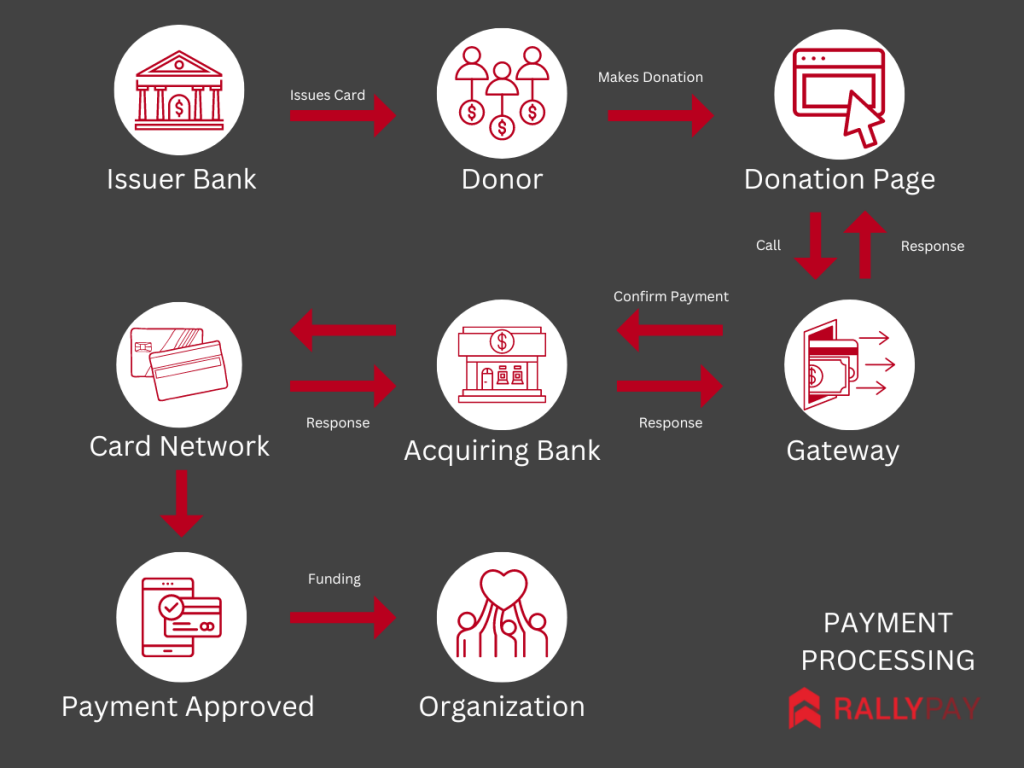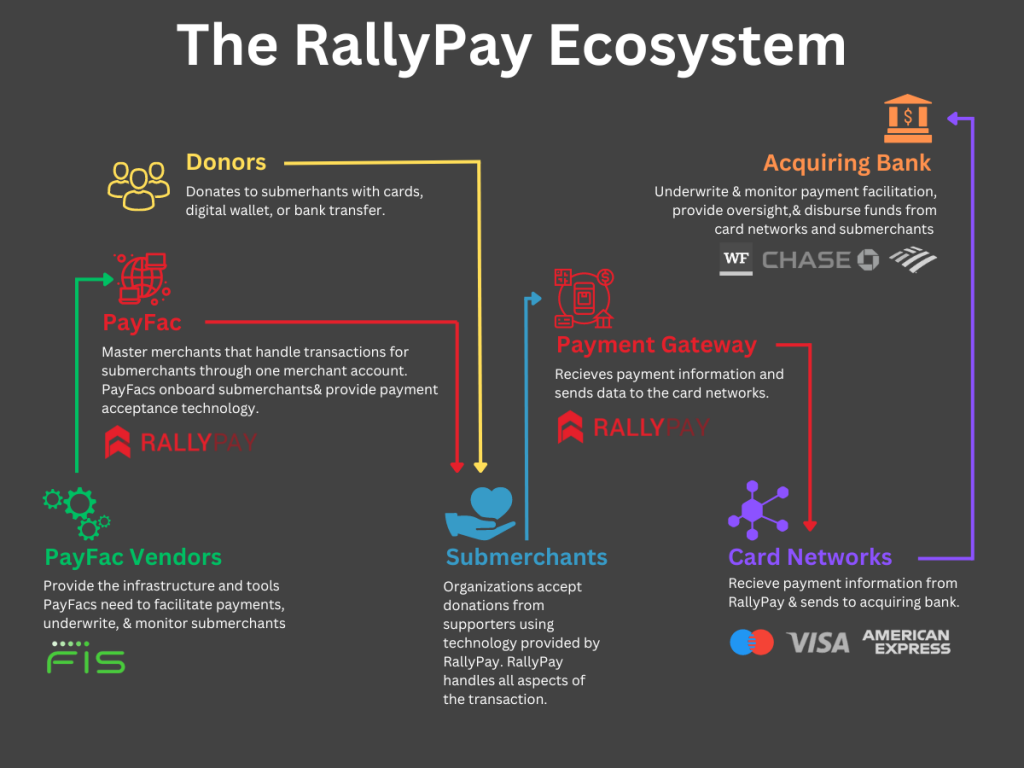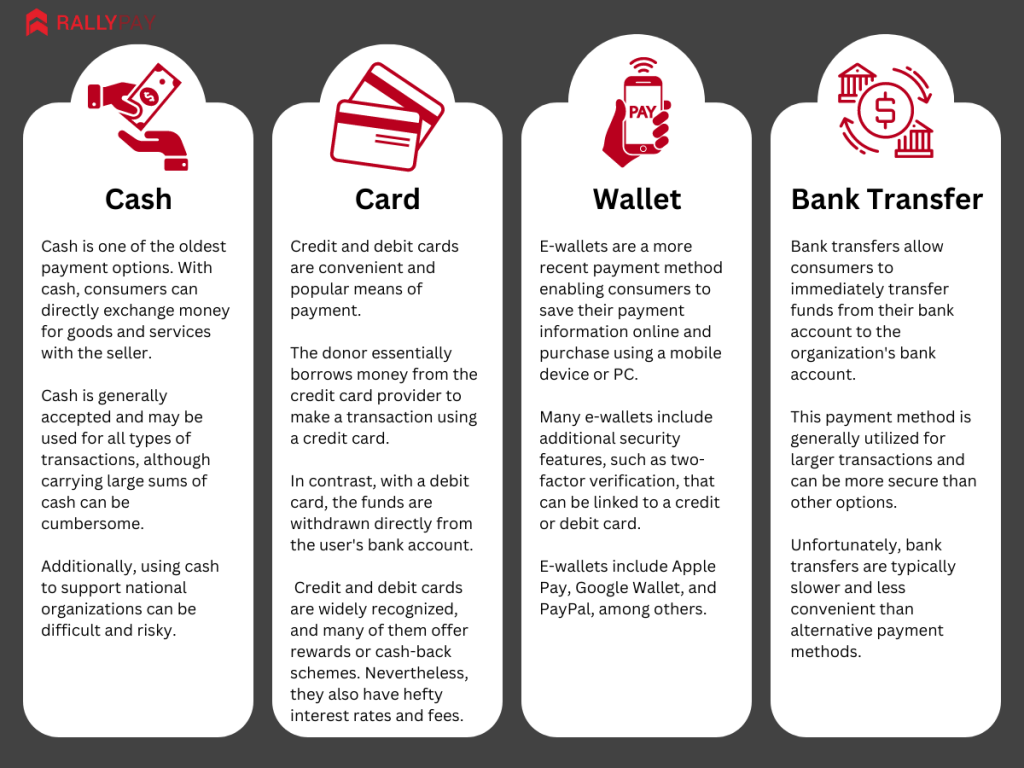I. Introduction
In the fast-paced digital world of the twenty-first century, payment processing has become indispensable to daily life. Whether you are purchasing at a grocery store, donating to a charity, or paying for a service online, payment processing is the method by which these transactions are accomplished. Yet, what is payment processing, and why is it so crucial?
In this post, we’ll focus on nonprofits, charities, and political organizations and examine the stages involved in payment processing, the role of payment processors, and the four most common payment methods. By the end of this article, you will better know how payment processing works and why it is essential in today’s digital fundraising environment.
II. What is Payment Processing
Payment processing refers to the actions necessary to complete a transaction between a donor and an organization. It involves the transfer of funds from the donor’s account to the organization’s account and involves multiple procedures to assure the security and accuracy of the transaction.
Historically, payment processing was performed manually using cash, checks, and money orders. Yet, as technology advanced, payment processing has became more efficient and simplified. Today, payment processing is often performed electronically using various technologies and standards to expedite and assure the accuracy and security of transactions.
Payment processing aims to facilitate transactions and provide a secure and efficient method of transmitting funds. Payment processing is vital for fundraising organizations of all sizes because it enables them to receive payments from donors and clients around the globe. In addition, payment processing is essential to e-commerce and online transactions since it allows buyers and sellers to complete transactions without exchanging cash or checks.
III. What are the Steps in Payment Processing

Payment processing requires multiple stages that must be completed to ensure the security and accuracy of a transaction. Authorization, authentication, and settlement are these steps.
Authorization is the initial stage in the payment processing procedure. It entails confirming that the buyer has adequate finances to execute the purchase. Authorization may require calling the donor’s bank or credit card provider through our payment gateway to check the account balance.
The next step in payment processing is authentication. It involves confirming the donor’s identification and establishing the transaction’s legitimacy. Authentication may entail inputting a password or PIN, providing a security code or token, or utilizing biometric verification, depending on the payment method. At RallyPay, we use a combination of methods to authenticate transactions and prevent fraud.
After authorization and authentication, settlement is the concluding phase of payment processing. It entails moving money from the donor’s account to the organization’s. Depending on the payment type chosen, a settlement could occur instantly or take several days.
The overall purpose of the stages involved in payment processing is to ensure that transactions are executed accurately and securely. By adhering to this process, payment processors can aid in reducing the risk of fraud and protecting both donors and fundraisers.
IV. What Do Payment Processors Do?

Payment processors provide the necessary infrastructure and technology to conduct transactions between buyers and sellers. They perform a crucial role in the payment processing system, ensuring all transactions are accurate and safe.
There are a variety of payment processors, such as acquirers, issuers, payment facilitators (PayFacs), independent sales organizations (ISO), and gateways.
- Acquirers are the companies that assist merchants in establishing their accounts and provide the necessary technology to conduct transactions. • Issuers are banks or financial entities that provide consumers with credit and debit cards.
- PayFacs provide payment processing services to merchants directly, without the need for a traditional merchant account.
- ISOs are third-party organizations that work with payment processors to offer payment processing services to merchants.
- Companies that supply the technology required to connect merchants to the payment processing system are known as gateways.
To be clear, while both ISOs and Payment Facilitators provide payment processing services to merchants, the key difference is that ISOs work as intermediaries between merchants and payment processors, while PayFacs provide payment processing services directly to merchants.
RallyPay is an example of a PayFac with its own gateway. RallyPay works with acquiring banks and payment processors to offer payment processing services to their clients directly. We’re responsible for underwriting and onboarding new merchants, managing merchant accounts, and providing customer support.
As a result, we must comply with regulations and standards set by acquiring banks, payment processors, and card brands. Additionally, we ensure we provide FEC-compliant reporting to make it easier for nonprofits, charities, and political organizations to remain compliant with federal regulations. At RallyPay, we offer solutions for fraud detection and prevention, as well as reporting and analytics to assist organizations in gaining a deeper understanding of donor data.
PayFacs like RallyPay play a crucial role in the payment processing system by providing the infrastructure and technology necessary to facilitate transactions between donors and organizations.
V. Why is Payment Processing Important?
Payment processing is crucial to the modern economy, facilitating transactions between donors and organizations. The significance of payment processing is evident from both the corporate and consumer perspectives.
Payment processing enables businesses to receive payments from domestic and international customers and clients. Nonprofits, charities, and political organizations may partner with payment processors to provide donors safe and efficient payment options. These services help to increase sales and revenue, as well as enhance donor loyalty and happiness.
Payment processing provides a convenient and safe method for donors to support the causes and the candidates they care about. By utilizing payment processors, consumers can pay with various payment methods, such as credit and debit cards, e-wallets, and bank transfers. It gives donors additional flexibility and convenience, making donations and supporting causes more straightforward.
Nevertheless, payment processing is not risk-free. There is always the possibility of fraud or unlawful transactions, for instance. To mitigate these risks, payment processors implement a variety of security measures, including encryption, two-factor authentication, and fraud detection and prevention systems. In addition, payment processors frequently have dispute resolution mechanisms in place to assist with resolving any potential concerns.
In addition to the methods above, at RallyPay, we use an internally built secure gateway to prevent fraudulent transactions from occurring in the first place. We block transactions from donors who show a history of repeat chargebacks, prevent traffic that appears suspicious or fraudulent, and protect organizations from the risk inherent to digital fundraising.
It is impossible to exaggerate the importance of payment processing in the digital fundraising environment. By facilitating transactions between donors and organizations through an omnichannel approach, payment processing contributes to commerce and donor expansion. Without payment processing, it would be far more difficult for organizations to crowdfund support and for supporters to make donations.
IV. What are the 4 Main Methods of Payment

Numerous payment options are available to donors for donations and supporting causes and candidates. The following are the four most common payment methods:
- Cash is one of the oldest payment options. With cash, consumers can directly exchange money for goods and services with the seller. Cash is generally accepted and may be used for all types of transactions, although carrying large sums of cash can be cumbersome. Additionally, using cash to support national organizations can be difficult and risky.
- Credit and debit cards are convenient and popular means of payment. The donor essentially borrows money from the credit card provider to make a transaction using a credit card. In contrast, with a debit card, the funds are withdrawn directly from the user’s bank account. Credit and debit cards are widely recognized, and many of them offer rewards or cash-back schemes. Nevertheless, they also have hefty interest rates and fees.
- E-wallets are a more recent payment method enabling consumers to save their payment information online and purchase using a mobile device or PC. Many e-wallets include additional security features, such as two-factor verification, that can be linked to a credit or debit card. E-wallets include Apple Pay, Google Wallet, and PayPal, among others.
- Bank transfers allow consumers to immediately transfer funds from their bank account to the organization’s bank account. This payment method is generally utilized for larger transactions and can be more secure than other options. Unfortunately, bank transfers are typically slower and less convenient than alternative payment methods.
Numerous payment options are available to consumers, each with perks and downsides. By understanding these various payment methods, consumers can select the best option that matches their needs and preferences. At RallyPay, we support all the mentioned digital payment methods. We give donors the flexibility to donate securely in the manner most convenient to them. This means higher revenue for the organizations we support.
VII. Conclusion
In conclusion, payment processing is an integral component of the modern economy, as it facilitates transactions between buyers and sellers around the globe. By knowing the stages involved in payment processing, the role of payment processors, and the many payment options available, businesses and customers can make informed decisions and ensure transactions are processed accurately and securely.
From the days of cash and checks to the current computerized technologies, we reviewed the evolution of payment processing. In addition, we discussed the vital role that payment processors play in the payment processing system and presented instances of various payment processors. In addition, we explored the significance of payment processing for donors and organizations, the dangers connected with payment processing, and how RallyPay reduces these risks.
Finally, we discussed the four primary payment options: cash, credit/debit cards, electronic wallets, and bank transfers. By understanding these various payment methods, donors can select the best option that matches their needs and preferences.
In today’s fast-paced digital environment, payment processing knowledge is more crucial than ever. Nonprofits, charities, and political organizations and the donors that support them can enjoy the benefits of digital fundraising while limiting the dangers associated with payment processing by collaborating with payment processors and utilizing secure and straightforward payment options.